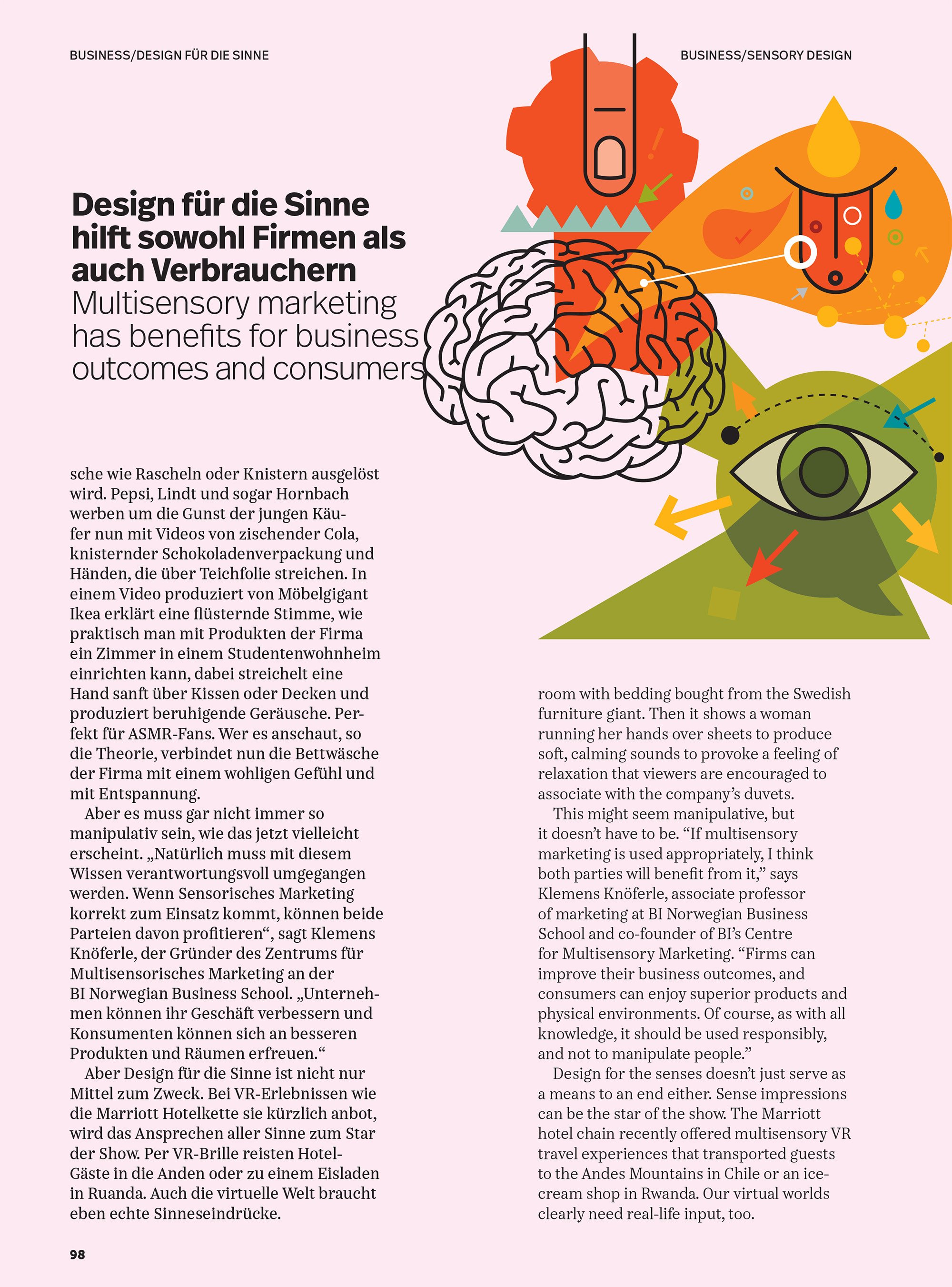Wings
Eurowings inflight magazine
Scents & Sensibilities
From coffee-scented gas stations to smooth jazz wafting through a mall, we explore if sensory design makes sense.



The smell of freshly baked bread, the feel of a fluffy cashmere jumper, rock music blaring from speakers in a jeans store – when we shop, it’s an experience that involves all our senses. The chef who sprinkles green herbs on top of his perfectly creamed mashed potatoes knows that, as does the designer of the luxury limousine who chooses the softest leather for the seat. When petrol station forecourts exude coffee aromas and our smartphone beeps a pleasant chord on login, we don’t give it much thought.
Yet these sensory experiences rarely come about by chance, but by deliberate design having been carefully developed and tested. As early as the 1930s, a study tried to establish what impact narcissus and fruit scents may have on the buyers of nylon stockings. A similar experiment conducted in 1993 by Alan Hirsch, founder of the Smell & Taste Treatment and Research Foundation, involved two pairs of Nike trainers in two separate rooms, identical apart from a floral scent in one of the rooms. A vast majority of people (84%) preferred the shoes displayed in the scented room, and the value of those shoes was estimated to be on average US$10 higher than those in the unscented room.
Then, at the beginning of this century, scientists started looking more systematically at the role our ears, eyes, nose, and skin play in making buying decisions. Eventually, sensory marketing started to find its way from academic conferences and papers into our shops, living rooms, and further afield.
American scent marketing company Prolitec has worked with brands worldwide and points to airports as beneficiaries. “Three-quarters of the emotions we generate on a daily basis are affected by smell,” says Prolitec’s Olivier Delenclos. “Scent can reduce the amount of time people believe they’ve spent waiting, making it popular in spaces like airport security.”
Experiences that target all the senses are gaining popularity. We spend so much time on phone and computer screens that our senses of smell, touch, and sound end up desperate for input. Millennials in particular are mad about ASMR (autonomous sensory meridian response) and made it a big hit on YouTube. The acronym describes an involuntary reaction – a pleasant tingling sensation – caused by crackling, rustling, and whispering sounds. Pepsi, KFC, and Ikea are among the brands trying to attract young audiences with videos of drinks fizzing and food wrappers crinkling. In an Oddly Ikea campaign video, a whispering voice extols the virtues of furnishing your college dorm room with bedding bought from the Swedish furniture giant. Then it shows a woman running her hands over sheets to produce soft, calming sounds to provoke a feeling of relaxation that viewers are encouraged to associate with the company’s duvets.
This might seem manipulative, but it doesn’t have to be. “If multisensory marketing is used appropriately, I think both parties will benefit from it,” says Klemens Knöferle, associate professor of marketing at BI Norwegian Business School and co-founder of BI’s Centre for Multisensory Marketing. “Firms can improve their business outcomes, and consumers can enjoy superior products and physical environments. Of course, as with all knowledge, it should be used responsibly, and not to manipulate people.”
Design for the senses doesn’t just serve as a means to an end either. Sense impressions can be the star of the show. The Marriott hotel chain recently offered multisensory VR travel experiences that transported guests to the Andes Mountains in Chile or an ice-cream shop in Rwanda. Our virtual worlds clearly need real-life input, too.